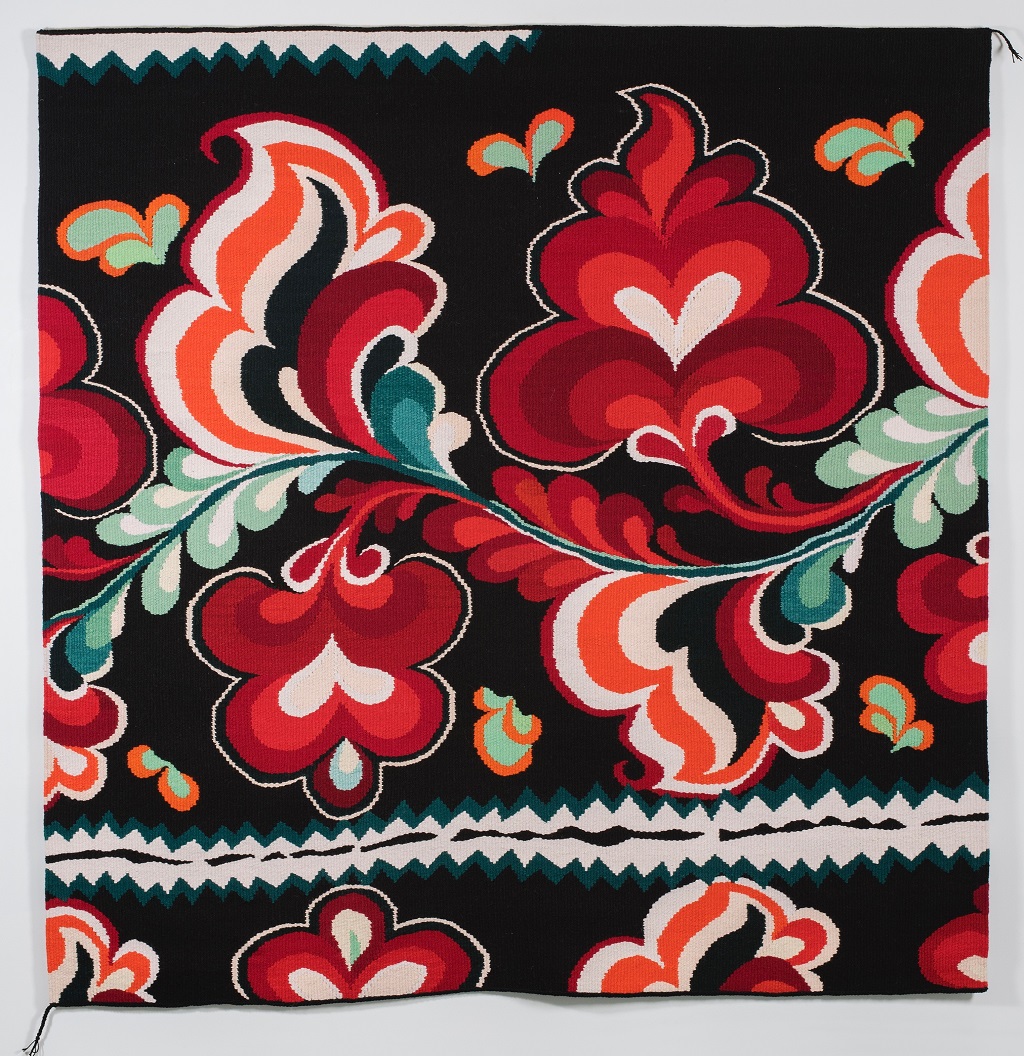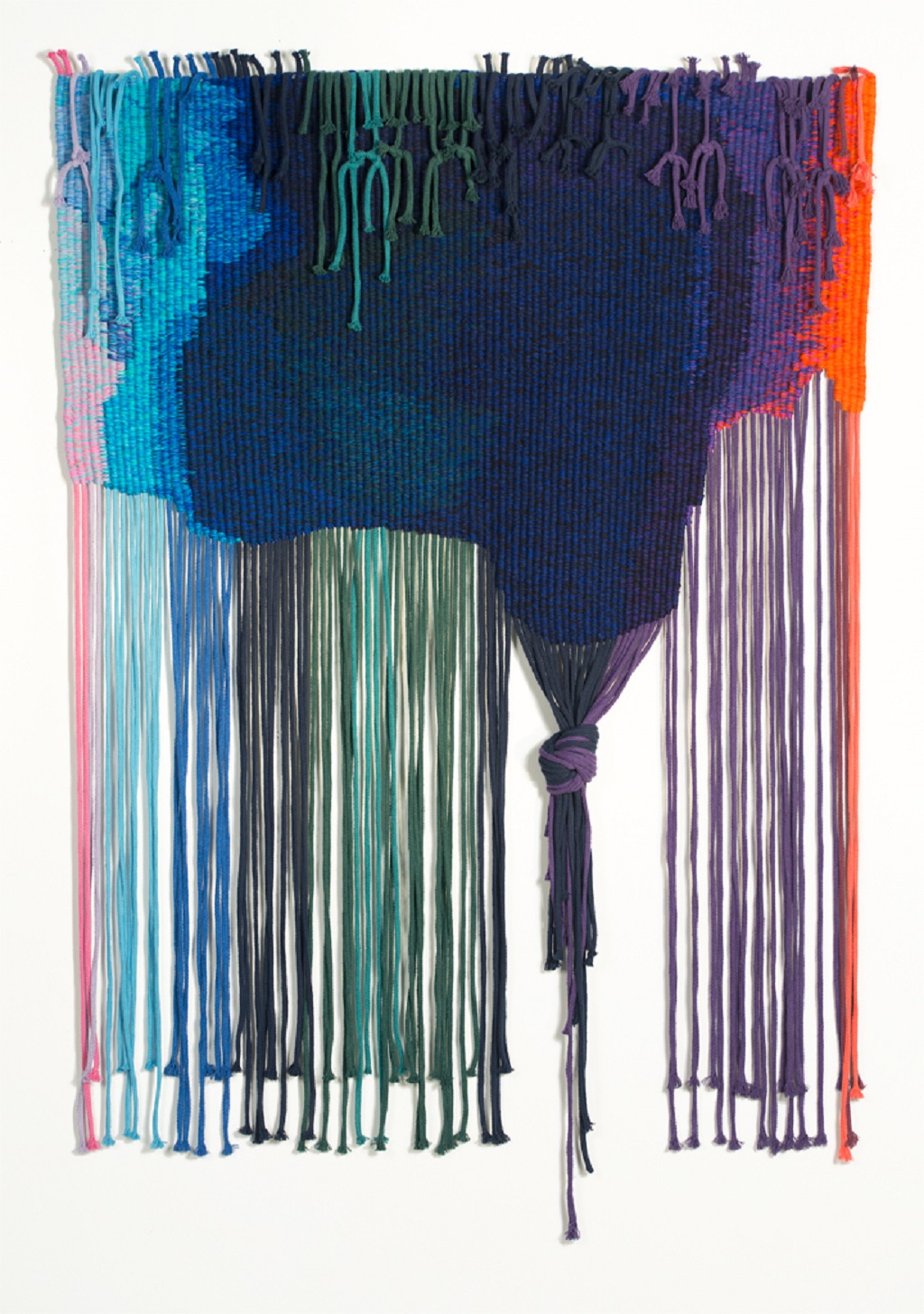The world’s biggest prize for tapestry, The Cordis Prize has announced the shortlist of weaving artists who are in the running for the title.
The shortlist of 17 artworks by 16 artists will be considered for the £8000 prize and exhibited to the public at Inverleith House Gallery in Edinburgh from 16 March to 27 May 2019.
Selected from 75 submissions by artists from as far afield as India, Australia, and Russia, those chosen include renowned weavers from Japan, Serbia, Norway, Canada, Denmark, Hungary and the United Kingdom.
Created to reward ambitious and skilled use of tapestry weaving techniques the prize captures a snapshot of how this classic artform is being developed today. Artworks selected include the use of materials from paper streamers to yoga mats as well as traditional threads such as cotton linen integrated with wire, ash keys and more.
Exploration of colour and materials sit alongside artworks spotlighting social issues such as displacement from war, resistance to ethnic diversity and Western appropriation of Eastern ideals.
The 2019 Cordis Prize Shortlist has been selected by a judging panel convened by co-founder Miranda Harvey and consisting of: Fiona Mathison, former head of Tapestry at Edinburgh College of Art and former Artistic Director at Dovecot Studios, Jo Barker, internationally renowned tapestry artist and winner of the 2017 Cordis Prize, acclaimed fashion and portrait photographer David Eustace, Charlotte Higgins, chief culture writer for The Guardian and Emma Nicolson, Head of Exhibitions at Royal Botanic Gardens Edinburgh.
Cordis Prize founder Miranda Harvey said: ‘Selecting this shortlist was an animated, exciting, good-humoured collegiate enterprise. I am grateful to my fellow-judges for bringing their technical expertise, aesthetic judgement and enthusiasm to the task.
‘The result is a group of works designed to astonish and delight in the wonderful setting of Inverleith House. Cordis has a reputation for embracing the contemporary aspects of textile art, as well as honouring the age-old craft foundations of tapestry.
‘This year the show contains multiple qualities: complexity and simplicity, accessibility and bewildering, brilliance and modesty, robustness and delicacy. It is in the nature of tapestry to work on multiple levels, from across a room or close up. We hope that these pieces will speak amongst themselves as well as to the viewer, and that the conversations they set off will be as joyful and lively as the ones we had in choosing them.’
The 2019 Cordis Prize shortlist is:
Anna Olsson (Sweden) Before the Disaster – Dish Brush 120cm x 120cm
‘With the imagery I want to discuss what we are taking for granted today, but which can quickly become an almost unattainable luxury. What do we value today and what will we miss?’
Anna Ray (Hertfordshire, UK) – Tassel 200cm x 550cm
‘In my twenties I found out that some of my ancestors were French Huguenot silk weavers and trimmings manufacturers, living and working in Spitalfields in the 1700s. This was a thrilling discovery and gave me a strong connection to London when I first moved to the city. I began to imagine the different textile forms that my ancestors may have created in silk, cotton, linen and wool, which led me to make ‘Tassel’. This is a sensual work, rich in colour: the span of elements sway gently on the wire supports.’
Anne Stabell (Norway) – Summer in the Woods 215cm x 220cm & Symbiosis (Lichen) 240cm x 130cm
‘I am working with a series of transparent tapestries named ‘Waldeinsamkeit’. The concept of the german word Waldeinsamkeit represent the idea of being alone in the woods. It suggests a calm, contemplative atmosphere amidst a beautiful setting. Like solitude, meditation, and contemplation, as in the phrase ‘being at one with the universe’.’
Birgitta Hallberg (Denmark) – Sunday Morning 125cm x 116cm
‘Birgitta takes us on a journey to the garden of childhood, inspired by the country of her childhood in Skåne, where her mother often would photograph Birgitta in their garden.’

Brita Been – Vine
Brita Been (Norway) – Vine 250 x 245cm
‘Many threads from textile histories` treasure chest unite in Brita Beens` energetic contemporary art. Style and tradition cannot be seperated from meaning. The handwoven work itself expresses the humane in an otherwise rational and anonymous world.’
Emma Jo Webster (Glasgow, UK) – Colour Shift I 184cm x 126cm
‘This tapestry is the start of a new body of work exploring the depths and luminosity of colour. I have always been mesmerised by colour. Sometimes I just want to jump in and be enveloped by it. I love and am enchanted by the way it blooms and pools…… the saturated depths of colour to the fresh translucent pure colour.’
Jessica Brouder (Canada) – Wheel 125cm x 150cm
‘This series of tapestries was inspired by the legend of Dido Queen of Carthage drawing a line around/claiming modern day Tunis with an ox’s hide cut into thin strips tied end to end incorporating the shoreline.’
Joanne Soroka (Serbia) – For Irena Sendler 129cm x 186cm
‘Irena Sendler worked with others to smuggle 2500 children and babies out of the Warsaw Ghetto and to find foster families who hid them for the duration of the war. This tapestry is in her honour, since she did not get the recognition she deserved during her lifetime.’
Katharine Swailes (Sussex, UK) – Le Bric et de Broc 120cm x 300cm
‘Le Bric et de Broc created from the odds and ends, is an abstract innerlandscape, the weaving created through thorough preperation. The focus during weaving on the physical activity, the image appearing through eight meter lenghts of wool and cotton butterflies randomly picked and mindfully placed pass by pass.’
Linda Green (Edinburgh, UK) – Up to and Over the Edge 184cm x 126cm
‘This work explores the reinforcement lines by repeatedly drawing over them again and again, remaking the boundary or gradually moving or removing it thereby inadvertently or deliberately claiming more space. This practice is controversial. Boundaries are volatile areas which can spark reaction. ‘Over the Edge’ can quickly become ‘Crossing the line,’ a phrase that issues a warning about what is deemed unacceptable sometimes signifying conflict.’
Li´via Pa´pai (Hungary) – Way to Light 180cm x 180cm
‘My concept has been inspired by my Roman sketches created as part of the verra-icon theme, and the golden and silver cerement plates. The solution was finally brought about by an epitaph from the City Museum of Nantong, and a stone hole from a similar object. The text of the female epitaph records the details of the birth and death of the person in question in accordance with burial customs of the era, and her life story.’
Louise Martin (Clackmannanshire, UK) – What is Green? 145cm x 175cm
‘A continuous warp links over two hundred elements woven with paper yarn. Unlike other yarns, paper creates a robust structure which can maintain its shape. Landscape and travel inform my pieces, combined with a strong influence in technique, structure and form.’
Philip Sanderson (West Sussex, UK) – A Million Billion 129cm x 129cm
‘A Million Billion is part of a continuing body of work that (collectively) represents an exploration of material and scale within the medium of tapestry weaving. Over recent years I have developed a method of making work in which I use heavier gauge materials to create larger pieces that have greater physical presence with an emphasis on the quality of the woven surface.’

Emma Jo Webster – Colour Shift I
Rachel Johnston (Portsmouth, UK) – Subtle Increase 228cm x 147cm
‘Tapestry and the process of woven construction lie at the heart of all my work. For some years I have experimented with the notion of embodied narrative using the tapestry technique to make shoe and glove-like forms that are worn in specific environments, most often in water. More recent large-scale pieces take this idea a stage further. In these, an embodied sense of place, the experiential ‘moment’, is realised and conveyed in the woven structure of the object itself.’
Susan Mowatt (Edinburgh, UK) – Red White and Blue Streamers 224cm x 173cm
‘The work, Red, White and Blue Streamers, consists of three parts. Each part is constructed from paper streamers, traditionally used for hanging in celebratory tangles (for me, from the windows of song-filled double decker buses, a memory of Sunday School picnics).’
Yasuko Fujino (Japan) – A Blind Garden 170cm x 380cm
‘I was weaving this tapestry inspired by a story by Anthony Doerr “All the Light We Cannot See”. The following sentence that expresses “visible and color” in this book is the trigger of this work. But the electromagnetic spectrum runs to zero in one direction and infinity in the other, so really, children, mathematically, all of light is invisible.’
Taking place on the opening day of The 2019 Cordis Prize Exhibition will be a dedicated symposium – The Thread Runs Both Ways: Heritage and the Future of Tapestry Art, bringing together an international panel of speakers to discuss and debate the wealth of talent and creativity in contemporary tapestry. The symposium takes place at The Royal Botanic Gardens on Saturday 16 March, 10am – 4pm.
The symposium is one of two new initiatives developed by the Cordis Trust this year. The second, The Physic Garden Group Tapestry is a collaborative woven tapestry divided into 64 sections, each measuring 6 inches by 4.5 inches to be completed by an individual weaver, under the expert supervision of weaver Jo McDonald. Designed by Natalie Taylor The Physic Garden Group Tapestry will be the largest collaborative woven tapestry piece made in Edinburgh in living memory.
On completion it will be displayed on loan in the Education Centre of the Palace of Holyroodhouse, where it will celebrate the re- creation of the Physic Garden there, to be opened later this year.
There is free admission.
Click HERE for more information.
TAGS

